
08 Oct TIO MASS.: MASS MoCA, A Phoenix
The Site: A Phoenix
It’s Bilbao all over again, a story of a museum reviving a surrounding town.
Starting in colonial times, North Adams was a prosperous place of wholesale shoe manufacturers, the site that is now MASS MoCA variously filled with a brick yard, a saw mill, cabinet-makers, hat manufacturers, machine shops for the construction on mill machines, marble works, sleigh makers and an ironworks. Thirteen acres of grounds or about one-third of the city’s current business district.
From 1860 – 1942, the print works of O. Arnold and Company established themselves on a portion of the site and for the next 40 years, Arnold was the largest employer in town. Falling cloth prices and the lingering effects of the Great Depression, however, brought the curtain down on the company’s long run.
Enter Sprague Electric. In ’42, the company converted the former textile mill into an electronics plant, where physicists, chemists, electrical engineers and skilled technicians designed and manufactured crucial military components for many of the high-tech weapons used in WWII, including the atomic bomb. From the post-war years until the mid-1980s, Sprague produced parts for the booming consumer electronic market, until competition from lower-priced materials made abroad forced the company to close operations on Marshall Street.
Just one year later, in 1986, business and political leaders in the community began looking for ways to re-use the sprawling complex of bridges, viaducts, elevated walkways, and red brick facades.
MASS MoCA, originally conceived as an institution for the display of contemporary visual arts, has evolved under the leadership of its director Joe Thompson into a center designed to support and promote cutting-edge works.
“Mass MoCA is an open platform that fosters a dynamic dialogue between artist, artworks, place and visitor. It is a laboratory for fabrication and presentation of new works in the visual and performing arts – and those that merge the two disciplines – as well as emerging areas of the arts that incorporate new media and forge new vocabularies,” Thompson explained.
MASS MoCA celebrated its opening in 1999, launching the site into its third century of productivity – and the continuation of innovation and experimentation in the complex.
No doubt about it, MASS MoCA is a Phoenix, the mythological bird that rises from the ashes more glorious than it was in its previous incarnation.
Which is why Xu Bing’s Phoenix Project, an extraordinary installation curated by Thompson, is also a perfect avatar (or two perfect avatars) for the site.
Xu Bing: Phoenix & More (on view through October 27)
The birds are installed in the 300-foot-long main gallery, Mass MoCA’s signature space, Building 5, suspended in flight from overhead trusses. The male, Feng, measures 95 feet long; the female, Huang, is nearly 100 feet in length, beak to steel tail feathers. Internally lit with thousands of L.E.D.’s, the rough hewn creatures magically transform themselves by night into delicately shimmering constellations.
Xu Bing fashioned the works from garbage and construction waste in response to the shock and dismay he experienced after viewing one of China’s many construction sites. The sleek modern building was going up on the backs of poor workers laboring under dismal conditions, a pattern being repeated throughout a country experiencing hysterical growth.
The Phoenix Project hovers at the nexus of economic development and social injustice, challenging the status quo. Appropriation, re-imagining, re-purposing and resurrecting lie at the heart of Xu Bing’s creations.
Another major project features a faux tiger skin Xu Bing made from about 500,000 cigarettes arranged so that the white papers and tan filters create the illusion of the animal’s markings. 1st Class (2011) is a symbol of colonialism and luxury in Asia and a reference to the history of the global tobacco trade, a boon to many economies, and the industry’s complex role as both favored indulgence and dire health threat.
“Backstory,” a large vertical light box, is based on an ancient work owned by the Metropolitan Museum of Art. To replicate “Landscapes Painted on Double Ninth Festival,” Xu Bing again worked with a collection of waste materials, this time, fired plants and other debris. He arranged the detritus for all the world to see on the reverse of frosted glass panels, recreating the mountain and trees, ink washes, lines, textures, and brushstrokes. The artist claims the work is a dialogue with artists who have come before him. He has also compared his method of working to painting with light rather than pigment.
What you see with Xu Bing is not what you get.
It’s a whole lot more.
Xu Bing, in good company:
Xu Bing, an art world heavy, is in good company at MASS MoCA.
In 2008, MASS MoCA joined forces with the Yale University Art Gallery, the Williams College of Art, and the studio of Sol LeWitt to organize a 25-year exhibition devoted to the artist’s jazzy wall drawings.
LeWitt became known (back in the Sixties) for reducing art to basic shapes (quadrilaterals, spheres, triangles) and colors (mostly red, yellow, blue and black). His work helped to establish two postwar movements: Conceptualism and Minimalism.
Beyond Xu Bing, there’s also an entire building, 10,000 square feet, specifically re-purposed in conjunction with the Hall Art Foundation and dedicated to the art of Anselm Kiefer, a German artist whose work is characterized by an unblinking willingness to confront his culture’s dark past.

Anselm Kiefer, Hall Art Foundation at MASS MoCA
Kiefer is known for working large, the confrontational scale in direct proportion to the horrors the artist chooses to address. The MASS MoCA exhibition, which went on display late September, includes an 82-foot-long wave-like sculpture, Etroits sont les Vaisseaux or Narrow are the Vessels, (2002), made of cast concrete, exposed rebar, and lead. Earthquake meets high art.
The second room holds Les Femmes de la Revolution or The Woman of the Revolution, (1992), is comprised of 20 lead beds accompanied by photographs and wall text. No morgue could feel colder or more forbidding.
Velimir Chebnikov, a steel pavilion containing 30 paintings that deal with nautical warfare and inspired by the quixotic theories of the Russian mathematician Chlebnikov, was designed specifically for the daunting installation. The images are darkly beautiful.
“Plus que ca change, plus c’est la meme chose.”
(The more things change, the more they stay the same.)
The Kiefer exhibition is as chilling as it is thrilling.
Like the dead soldier in Plato’s “Republic,” you want to look away, but you can’t.
Up and coming:
To round out our all too brief overview of MASS MoCA, we got to enjoy the work of three emerging artists.
The museum’s three-story, first-floor gallery features about 12 new works by Jason Middlebrook, all about the complex relationship between man and nature.
My Landscape includes the artist’s hardwood plank series in which Middlebrook’s use of hard-edged lines and glossy, industrial colors creates a striking contrast to the wood’s organic shapes. The series beautifully communicates the intrusion of industry on verdant landscapes.
Middlebrook’s 28-foot high fountain made of styrofoam and suspended from the ceiling is arguably the most elegant comment to date on the inelegant practice of polluting our waters with plastic waste.
Joseph Montgomery’s Five Sets, Five Reps marks the New York-based artist’s first color museum show.
Evoking works by a wide range of influences, including Paul Klee, Robert Rauschenberg, Frank Stella, and Kurt Schwitters, plus Arte Povera constructivism, and minimalism, the artist sorts, dissects, and builds upon existing images and image fragments which seem to recur and and self-perpetuate over time. Reminiscent of architectural fragments, the works exhibit strong ties to the world of architecture and building. Yet their small scale suggests a figurative presence.
Paris-based sculptor Guillaume LeBlon celebrates his first major solo exhibition at an American museum.
Under My Shoe features 15 works made over the past five years by the artist, including woven metal sculptures and a series of plaster wall “paintings” reminiscent of Egyptian sculptural reliefs and classical Greek statuary.
A latter-day Pop artist, the wry eye of Leblon elevates the quotidian to high art worthy of contemplation.
In conclusion:
Now is possibly the best time to make a pilgrimage to MASS MoCA, the eye-dazzling fall colors en route from almost anywhere, a drumroll for all the hot shows at this very cool museum.


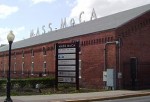
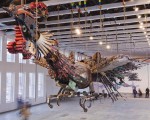
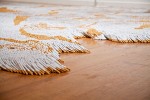

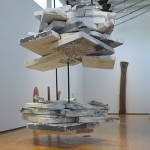
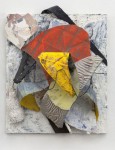

Carol Kiendl
Posted at 07:10h, 15 OctoberSo glad that you share my love for MASS MOCA! Than ks for coming to visit. Carol